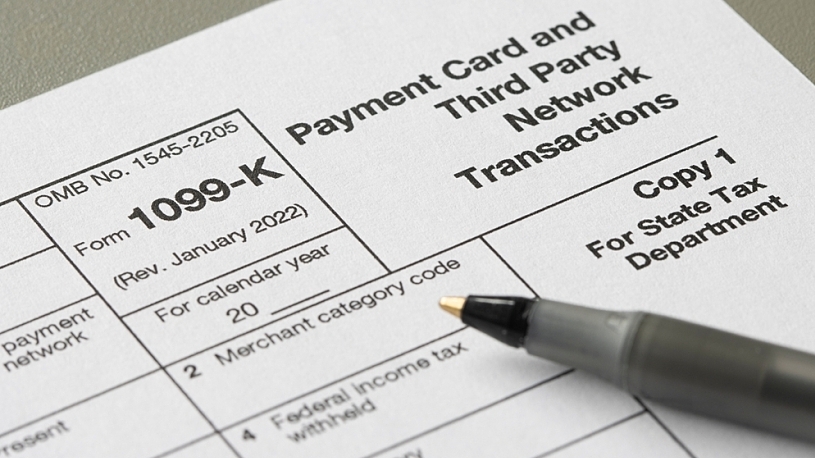What Is a 1099-K, and How Does It Differ from a 1099-NEC?

- A 1099-K and a 1099-NEC are two tax forms used for reporting payments to vendors and independent contractors.
- A 1099-K only applies to companies that process transactions through a payment card, app or online marketplace. Employers might receive a 1099-K for collecting payments, but most don't have to prepare one.
- The 1099-NEC form is more common. All businesses must file a 1099-NEC for every contractor or freelancer they pay more than $600 in a year.
If your business paid independent contractors and vendors during the past calendar year, you must send them their 1099 informational tax forms by Jan. 31. It's an IRS requirement to send these out because self-employed workers need this information to prepare their tax returns.
What often causes confusion is that there are different versions of the 1099 — the 1099-K and 1099-NEC. Here's what you need to know about the differences between them.
What is a 1099-K?
Form 1099-K is used for payment card transactions through third-party networks. It generally applies to debit, credit and prepaid card payments processed through parties like VISA, Mastercard, PayPal or Square. It also includes networks like Uber and Airbnb, which process payments between customers and vendors or freelancers.
Settlement organizations use this form to report when they send a vendor or freelancer card or network transactions during the year. However, a vendor or freelancer only receives this tax form if they have more than a minimum number of transactions and total payments. For 2023, a vendor or freelancer receives a 1099-K form if they have over 200 transactions through the card or network and over $20,000 in payments, according to the IRS.
In 2024, the IRS plans on reducing the reporting threshold to $5,000 in payments. Over time, the IRS expects to reduce the 1099-K reporting limit to $600.
Who sends a 1099-K?
Only certain types of businesses send a 1099-K. Payment apps and online marketplaces prepare these tax forms for users and the IRS. It's how the IRS tracks payments people receive for an online business. Credit, debit and gift card companies may also send out a 1099-K. Other types of businesses generally don't need to prepare this tax reporting form.
"Unless you're running a third-party settlement network, chances are good that you will not be sending out Forms 1099-K," says Ellen Feeney, Vice President, Counsel at ADP. "However, you could receive one if your business meets the transaction threshold."
1099-K vs. 1099-NEC
While the 1099-K and 1099-NEC both serve the role of reporting payments to the IRS, they serve two different categories. First, many businesses may need to complete and send out 1099-NEC forms.
The 1099-NEC lists compensation earned by self-employed workers like freelancers or independent contractors. This group does not include employees earning wages on a Form W-2 but rather workers who are paid by the project or job.
Whenever your business hires this type of worker and pays them $600 or more in a tax year, you must send them a 1099-NEC. The only exception is when the freelancer or contractor's business is incorporated.
The 1099-K only applies to third-party settlement networks processing transactions. Other businesses might receive a 1099-K if they receive payment through one of these networks, but they will not need to prepare a 1099-K.
Another difference is the reporting limit. The 1099-NEC threshold is much lower and applies when a vendor or contractor receives more than $600 in a year. The number of transactions does not matter.
A network only needs to send a 1099-K if someone receives over $20,000 and over 200 transactions in 2023.
Over time, the IRS plans to reduce the reporting threshold for the 1099-K to become more like the 1099-NEC. In 2024, it will reduce the payment limit to $5,000. Eventually, it plans to reduce the 1099-K limit to $600, the same as the 1099-NEC.
What is a 1099-K? |
What is a 1099-NEC? |
|
Usage |
Only by third-party settlement networks and cards |
Any business that hires contractors or freelancers |
Income reporting limit |
$20,000 of payments in 2023, $5,000 in 2024 |
More than $600 in payments to a contractor or freelancer |
Minimum transaction limit for reporting |
Yes, only after 200 transactions in 2023 |
No |
How should businesses prepare?
As is the case for anything tax-related, keeping accurate and comprehensive records is the best way to stay compliant with these IRS forms.
"Employers should make sure they are closely tracking all independent contractors so that anyone who meets or exceeds the 1099-NEC payment threshold receives a Form 1099," says Feeney.
Consider reminding freelancers and contractors to track their own income and compare it with the forms they receive so that they aren't only reliant upon your reporting.
It's also a good idea to start processing these forms as soon as possible. Every year, give yourself some breathing room to check whether you'll need to file 1099-Ks or 1099-NECs.
Learn more
Report, Worker Classification 101: Everything You Need To Know About Compliantly Managing Your 1099 Contractors
Webcast, The Future of Work & "Gig Economy." How will you manage the compliance risk associated with using freelancers at scale? What can we learn from companies who've already done so? Launch this webcast for the latest information.



